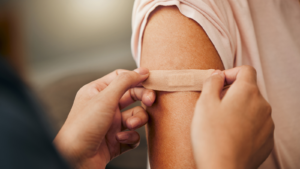The latest reports from national and state agencies are painting two different pictures of the United States and Connecticut – as vaccination rates fall nationally, they’re rising locally, to the extent that the state has the highest level of protection among kindergarteners in the country.
The American Hospital Association recently highlighted the Centers for Disease Control’s rates of vaccination for children during the 2024-25 school year. Vaccination rates for all tracked vaccines declined that year. On a national level, only 92.1% of children on average are protected with the DTaP, or diphtheria, tetanus and acellular pertussis vaccine, and only 92.5% have received the MMR, or measles, mumps and rubella vaccine and the polio vaccine.
Nearly 300,000 kindergarteners attended school in the 2024-25 school year without protection from the MMR vaccine, with exemptions from vaccines growing from 3.3% to 3.6%. About one-third of the country now has vaccine exemption rates higher than 5%.
CDC data shows that in the last five years, national DTaP coverage has declined from 94.9% in 2019-20 while national MMR coverage fell from 95.2% in 2019-20.
This news comes as measles is resurgent in much of the United States, with 1,333 confirmed cases in the country across 39 states so far this year. Measles has spread more than four times further than it did in 2024, with about 92% of infections coming from patients who were not vaccinated or had unknown vaccination status.
While national vaccination rates decline, the news is more positive in Connecticut. That same CDC data revealed that Connecticut ranked highest in the country for measles vaccination, as 98.3% of the state’s kindergarten students in the 2024-25 school year received the MMR vaccine. That’s up 0.5% in the last year, an increase that contrasts with national rates falling by 0.2% in the last year.
However, the most conclusive way to show the disparity between the nation and the state is simple. While nearly 80% of the country has seen a measles case, Connecticut has not had a confirmed infection of the disease since 2021.









